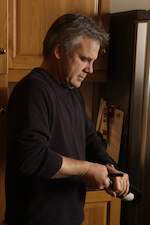From the start, investment on Villiera was vineyard and wine driven. Plantings of more classic varieties were guided by the farm's soils: the Kroonstad structure of sand over clay over gravel.

Extensive underground drainage was required, but once the roots went below the clay the vines needed either no irrigation or carefully applied drip irrigation, conducive to naturally low-yielding vines for quality wine.
The existing barn turned cellar was 'modernised' and expanded over time. Situated close to the cellar and tasting room is Jeff and Lynne's home. A nostalgic black-andwhite photograph shows Villiera's original farmhouse built in 1928 by the De Villiers family (who gave the farm its name). Then standing exposed, it's now a secluded haven surrounded by trees and gardens.
Jeff, after working with Arnold and travelling to Burgundy, was one of that era's young winemakers quick to follow up on new insights into the importance of small barriques in the development of fine reds (and later whites) as spearheaded locally by veteran vintners of the time. Similarly, he was a youngster in the vanguard of méthode champenoise sparkling wine production in the Cape.
The Griers had met the Denois family from Champagne: son Jean Louis visited the Cape with a dream to become involved in a bottle-fermented bubbly business as a consultant. It was the beginning of a close and enduring working relationship and friendship between Jeff and the Frenchman.
The first Villiera Tradition was released in 1984. The early vintages were made from the farm's existing chenin blanc with some pinotage while the Criers' newly planted chardonnay and pinot noir vines came on-stream. Though initially comprising non-traditional varieties, they were not mass-produced carbonated bubblies, but followed the time-honoured Champagne practices of early picked grapes, carefully prepared base wines (including some barrel fermented) and second fermentation in the bottle with time on the lees.
Jeff Grier the Cap Classique Specialist, subsequently played a leading role in the formation of the Cap Classique Producers Association in 1992. Far-sighted founder members drove the adoption of the uniquely South African term 'Cap Classique' for local wines made à la méthode champenoise. This was due to the prohibition by the French and adoption by the EU of the labelling as 'Champagne' of any wine other than that made in the French region.
It ensured that top-quality Cape exponents of the wine style could take advantage of the export market as soon-to-be democratic South Africa emerged from the world economic and political isolation. Now with a broad-based membership representing the strength of this category here and globally, it advises, encourages and acts as a touchstone of style authenticity and quality without stifling creativity for the Cape's legion of Cap Classique producers, small and large alike.
Jeff is now known as the Cap Classique specialist; Villiera's range of bubblies accounts for more than a third of their wine production. There is the Monro Brut, together with the Monro merlot-based red blend, standing as the farm's flagship brand. Monro is a family name: each son of the Grier clan carries it as a second name. There are also the Villiera Tradition Brut NV and Rose Brut NV (non-vintage traditionally indicating adherence to a house style that remains largely unchanged year after year).
Then there are those special little parcels for Cap Classique connoisseurs (or, as Jeff would quietly point out, why not anyone who just loves good sparkling wine). A Villiera Reserve Brut Rose was released as a one-off in magnum and after as long as nine years on its lees before being disgorged. The Villiera Shooting Star is a reserve cuvee made only in the best vintages and available solely on the Guild auction.
And for sparkling wine lovers who prefer something less dry than the traditional Brut, there is the Villiera Brut Special Dosage, just a touch sweeter than the two Traditions.
Though adhering to traditional Champagne winemaking methods, Jeff is also not averse to still adding a bit of Cape pride in the form of pinotage to some of his Cap Classiques, despite it not being recognised as a classic sparkling wine grape. It's a sign of the typical Grier sense of fun; a sign that while being a traditionalist and perfectionist, he's no conformist.
Jeff Grier also so much more than a Cap Classique producer. Besides the Monro Brut, his Monro red blend is his most awarded wine. And an award-winning streak in the late 1990s saw him win the Diners Club Winemaker of the Year in 1997 with his Bush Vine Sauvignon Blanc and in 1999 the Chenin Blanc Challenge with his Bush Vine Chenin Blanc.
The latter showcased the potential of old chenin vines as well as the variety's ability to age with just a little oak treatment to enhance its natural fruitiness. His win came at a time when the beginnings of the Cape's renewed love affair with this formerly ubiquitous variety saw some seriously heavyweight, wooded wines.
A trip to the Loire as part of his Challenge prize further 'inspired' Jeff Grier to explore this versatile variety's reputation for natural sweet dessert wines: the source of the Villiera Inspiration, an unusual combination with riesling, also a variety known for its development of Botrytis cinerea 'noble rot'.
 Pork fillet kebabs recipe by Jeff Grier paired with Villiera Traditional Barrel Fermented Chenin Blanc or Domaine Grier Grenache....
Pork fillet kebabs recipe by Jeff Grier paired with Villiera Traditional Barrel Fermented Chenin Blanc or Domaine Grier Grenache.... Marmite is the secret ingredient in this beef fillet recipe by Jeff Grier paired with Villiera Monro or the CWG Villiera Mother Earth red bl...
Marmite is the secret ingredient in this beef fillet recipe by Jeff Grier paired with Villiera Monro or the CWG Villiera Mother Earth red bl...